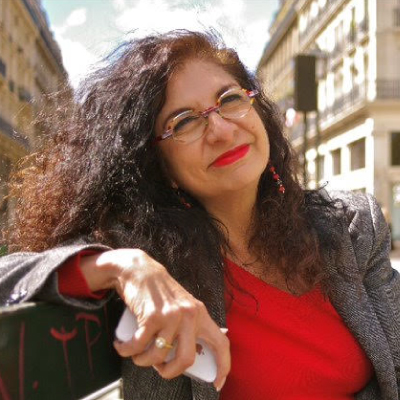Bussing Around Paris
Volume XVII, Issue 7
I ran into a colleague of mine on the 96 bus last night who takes it often, but admitted to not knowing the Paris bus system very well after living here as many years as I have. He didn’t realize that the Paris bus system is every bit as efficient, if not more so, than the Métro, and hadn’t bothered to learn it. Shameful!
I hear this all the time. For some reason, the average visitor and even many residents, don’t fully grasp the benefits of the Paris bus system and like him, make no effort to get to know it. If you’re here for a week, so “laisse tomber” (let it go), but if you’re about to buy property in Paris, the transportation that services the location can be key to your purchase decision. Don’t just look at the nearest Métro — be sure to check the bus routes that cross the area as well! (I always opt for the bus before taking a Métro!)
|
(All Photos by Erica Simone)
|
The buses can very often offer stops closer than the Métro, getting you closer to your destination. There are a whopping 63 bus lines within the city of Paris proper, and 214 bus lines in Paris suburbs. And the routes very often are more efficient and faster than the Métro, even when fully crossing the city. Night buses (called the “Noctilien”) mean that while the Métro is closed, you can still get close to home as well, without an expensive taxi ride (they run from midnight to 5:30 a.m., while the Métro and RER run from 5:30 a.m. to 1:15 a.m.). Midday is going to be your slowest ride, while early morning and late evenings are the fastest as the bus encounters less traffic and fewer stops.
The best part of all about bus riding is that they are above ground and you have the view of Paris. How can you get lost when you see exactly where you’re going? In addition, you avoid all those steps, so if you’re toting luggage or you’re physically challenged in any way, the buses are at sidewalk level and offer ramps for wheelchairs, strollers and the like. Switching to a second bus is free on the same ticket (within 90 minutes) — the same ticket you use for the Métro, but you must validate it each time. Most often, you can get off the bus at a particular stop that also services the second bus, so there’s no “commute” from one platform to another like there is at a Métro station.
Bus riding is by far more pleasant than the Métro. The people who take the buses differ from Métro-riders: more elderly, more parents with kids, more physically challenged and more smart people who know that taking the bus is better! While there is still some pick-pocketing on the buses, it’s a whole lot less than on the Métro.
Paris buses are operated by RATP, just like the Métro. Bus lines within the city have two-digit route numbers (from 20 to 96), while suburban lines have three-digit numbers. The bus map resembles the Métro map, color-coded and numbered. The ends of the line (or “terminus”) are what each route is named and all you need to know is in what direction you’re headed. On the bus stops and in the buses, the route is well posted, so it’s tough to screw up. And if you know the numbering system, it’s even easier (Source Wikipedia.org):
The first number represents the sector in Paris where the line’s starting point is located:
2- representing Gare Saint-Lazare
3- representing Gare de l’Est
4- representing Gare du Nord
5- represents Opéra and overall Rive Droite
6- represents Gare d’Austerlitz or Gare de Lyon
7- represents Châtelet and overall Center of Paris (along Rivoli Street)
8- represents Quartier Latin and overall Rive Gauche
9- represents Gare Montparnasse
The second number represents the outermost arrondissement the line finishes (or crosses Paris’ borders) in:
-2 represents the 16th arrondissement (from Pont du Garigliano to Porte Maillot)
-3 and -4 represent the 17th arrondissement (from Porte Maillot to Porte d’Asnières for lines ending in 3, from Porte de Clichy to Porte des Poissonniers for lines ending in 4)
-5 represents the 18th arrondissement and the 19th arrondissement (from Porte de la Chapelle to Porte des Lilas)
-6 represents the 20th arrondissement and the 12th arrondissement (from Porte de Bagnolet to Porte de Charenton)
-7 represents the 13th arrondissement (from Quai d’Ivry to Cité Universitaire)
-8 represents the 14th arrondissement (from Montsouris to Porte de Vanves)
-9 represents the 15th arrondissement (from Porte de Vanves to Pont du Garigliano)
0 and 1 are used as jokers for lines whose rightful number is already taken (21 for the rightful 28), or for lines ending inside of Paris (20 or 91 for example).
Tickets cost the same as Métro tickets. If you get on the bus with no ticket, the driver will sell you one for €2. You don’t have to have exact change, but it’s best not to give him/her a large bill. If you buy a “carnet” of 10 tickets, there is a 25% savings (€14.90 for 10). Reduced fares (€7.45 for 10) are for kids aged 4 to 10, large families, disabled veterans or other with a disability card, groups of 10 students or more accompanied by a teacher and the blind. Tickets can be purchased at Métro desks, automatic vending machines in the Métro stations and at authorized retailers…such as “tabacs” (so you don’t have to go down the stairs into the Métro station to get tickets).
Bus stops are in key spots and named appropriately — normally the name of the streets or intersections at which they are located. The route is posted on the stop and the number of minutes till the next bus arrives will also post. Once on the bus, the routes are posted along the top above your head and a reader board tells you what stop you are at, what’s up next and how long it will take to certain destination. (My only complaint is that the timing of the reader board is off — once the bus leaves the stop, it will still be touting that stop for quite a while after, so be careful not to be confused!)
The drivers are both men an women. Last night on the 96, the driver was one of the prettiest women I’d ever seen! Always, always, always say “Bonjour” to the driver when you get on. They will always acknowledge you in return. Those who don’t bother, are thought to be “ill mannered!” There’s usually no “queue” at the stop to get on the bus, like you might find in England, but everyone manages to courteously enter without rushing to be first. Certain seats are designated for the elderly, the pregnant, the physically challenged, etc., so be polite and leave them for those who need them more than you. If you have luggage, a trolley or pram, try to situate it in the center where it is the least disruptive. To ensure the driver will stop at your designated station, press any of the red buttons on the handle bars along the aisle, you might hear a beep and the words “Arrêt Demandé” will light up at the front of the bus indicating the driver will stop for you. Exit at the back of the bus, unless it’s so packed that you can’t make your way to the back, but ask the driver politely if you can get off at the front, again use your “politesse.”
To learn the routes, the easiest way is to visit the RATP.fr site. Enter your starting point and your ending point and let the site do the thinking for you. It’s not perfect, though. Sometimes I can out-think the computer and discover a better route for a variety of reasons. For example, once you know which buses run more frequently or which buses partly run along the same routes, you can get where you’re going faster. But, you’ll never know until you try!
That’s the point. Don’t ignore the buses. Learning them is easier than you think, and once you do, you’ll be a convert…like me…and maybe never take the Métro again!
Visit the interactive maps:
Daytime
Nighttime
Or download the PDF versions:
Daytime
Nighttime
You can also download the app to your phone to make it handy when you’re out and about.
A bientôt,
 |
Adrian Leeds
Adrian Leeds Group

P.S. Are you contemplating a move or at least a long stay in France? We can help you. With over 20 years living in France, we have learned the ins and outs and the inside information on moving, living and working here. Have a look at our Working and Living in France page and contact us today!
To read more, click the links below.









